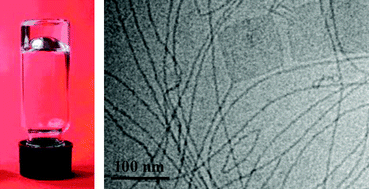Conformational and thermal behavior of a pH-sensitive bolaform hydrogelator
Abstract
The phase behavior of the symmetric long-chain

* Corresponding authors
a MLU Halle-Wittenberg, Institut für Physikalische Chemie, Mühlpforte 1, 06108 Halle, Germany
b MLU Halle-Wittenberg, Institut für Pharmazeutische Chemie, Wolfgang-Langenbeck-Str. 4, 06120 Halle, Germany
c Klinikum der FSU Jena, Elektronenmikroskopisches Zentrum, Ziegelmühlenweg 1, 07740 Jena, Germany
d FSU Jena, Institut für Pharmazie, Philosophenweg 14, 07743 Jena, Germany
e MLU Halle-Wittenberg, Biozentrum, Weinbergweg 22, 06120 Halle, Germany
The phase behavior of the symmetric long-chain

 Please wait while we load your content...
Something went wrong. Try again?
Please wait while we load your content...
Something went wrong. Try again?
K. Köhler, A. Meister, G. Förster, B. Dobner, S. Drescher, F. Ziethe, W. Richter, F. Steiniger, M. Drechsler, G. Hause and A. Blume, Soft Matter, 2006, 2, 77 DOI: 10.1039/B514163J
To request permission to reproduce material from this article, please go to the Copyright Clearance Center request page.
If you are an author contributing to an RSC publication, you do not need to request permission provided correct acknowledgement is given.
If you are the author of this article, you do not need to request permission to reproduce figures and diagrams provided correct acknowledgement is given. If you want to reproduce the whole article in a third-party publication (excluding your thesis/dissertation for which permission is not required) please go to the Copyright Clearance Center request page.
Read more about how to correctly acknowledge RSC content.
 Fetching data from CrossRef.
Fetching data from CrossRef.
This may take some time to load.
Loading related content
